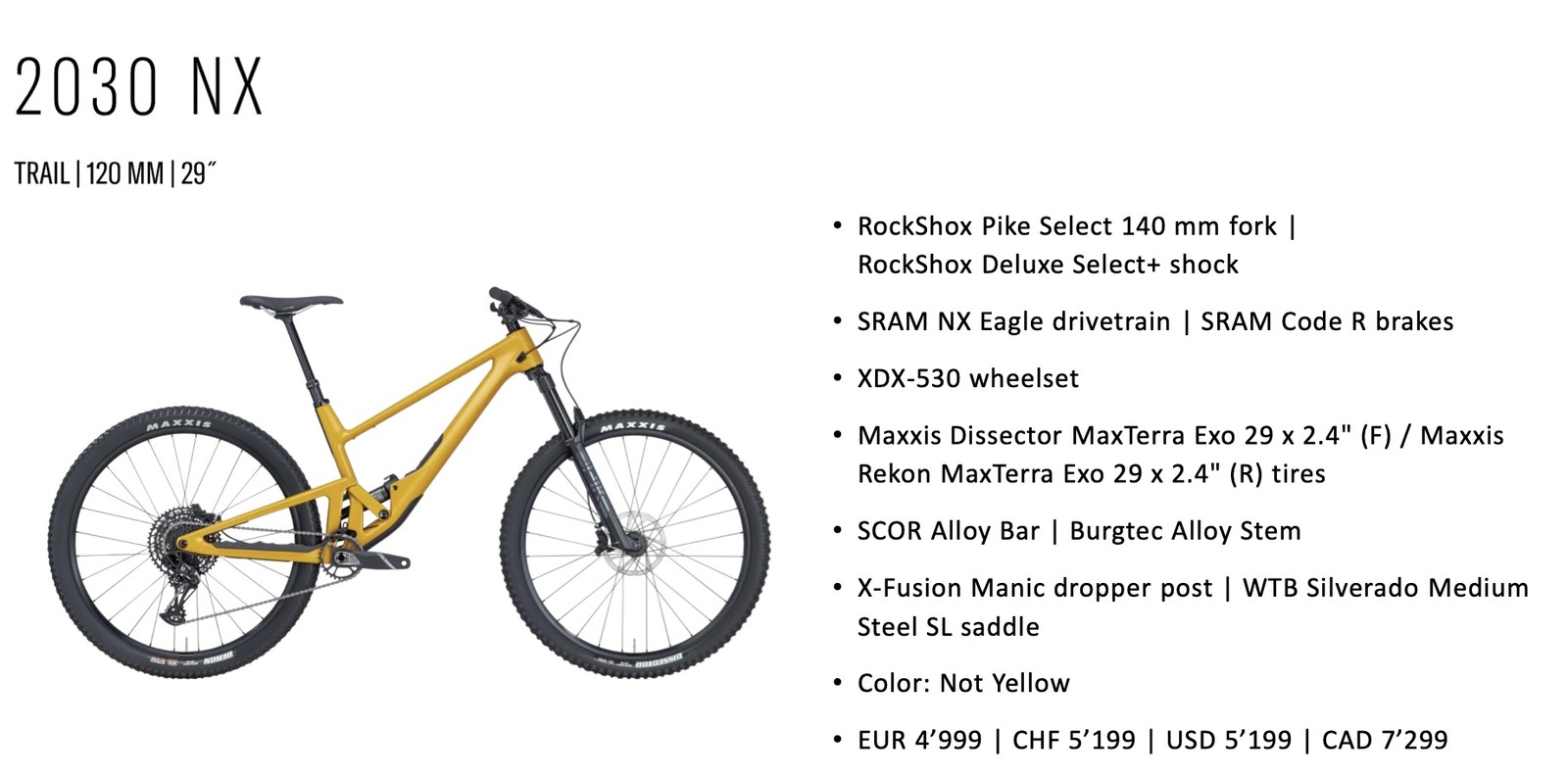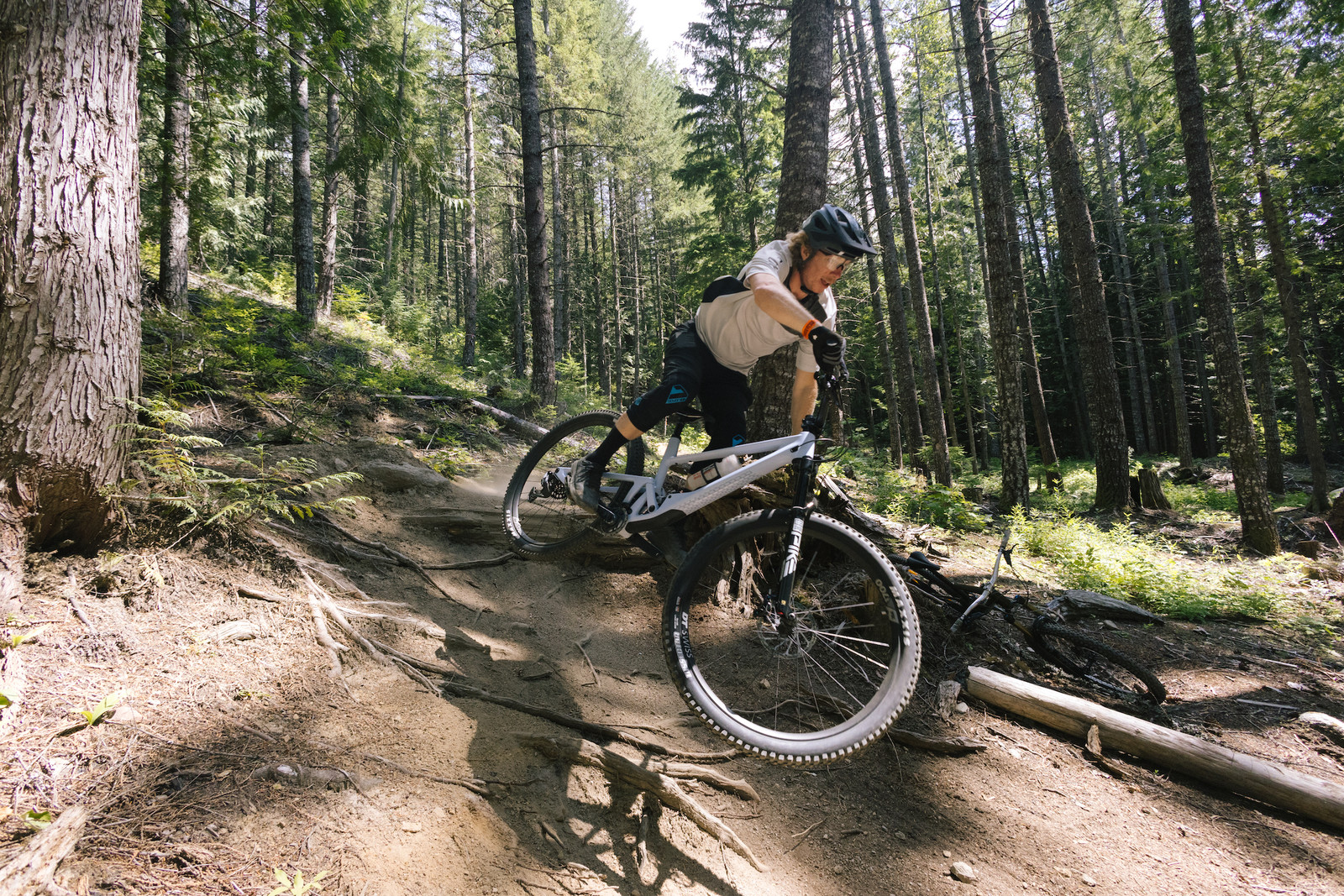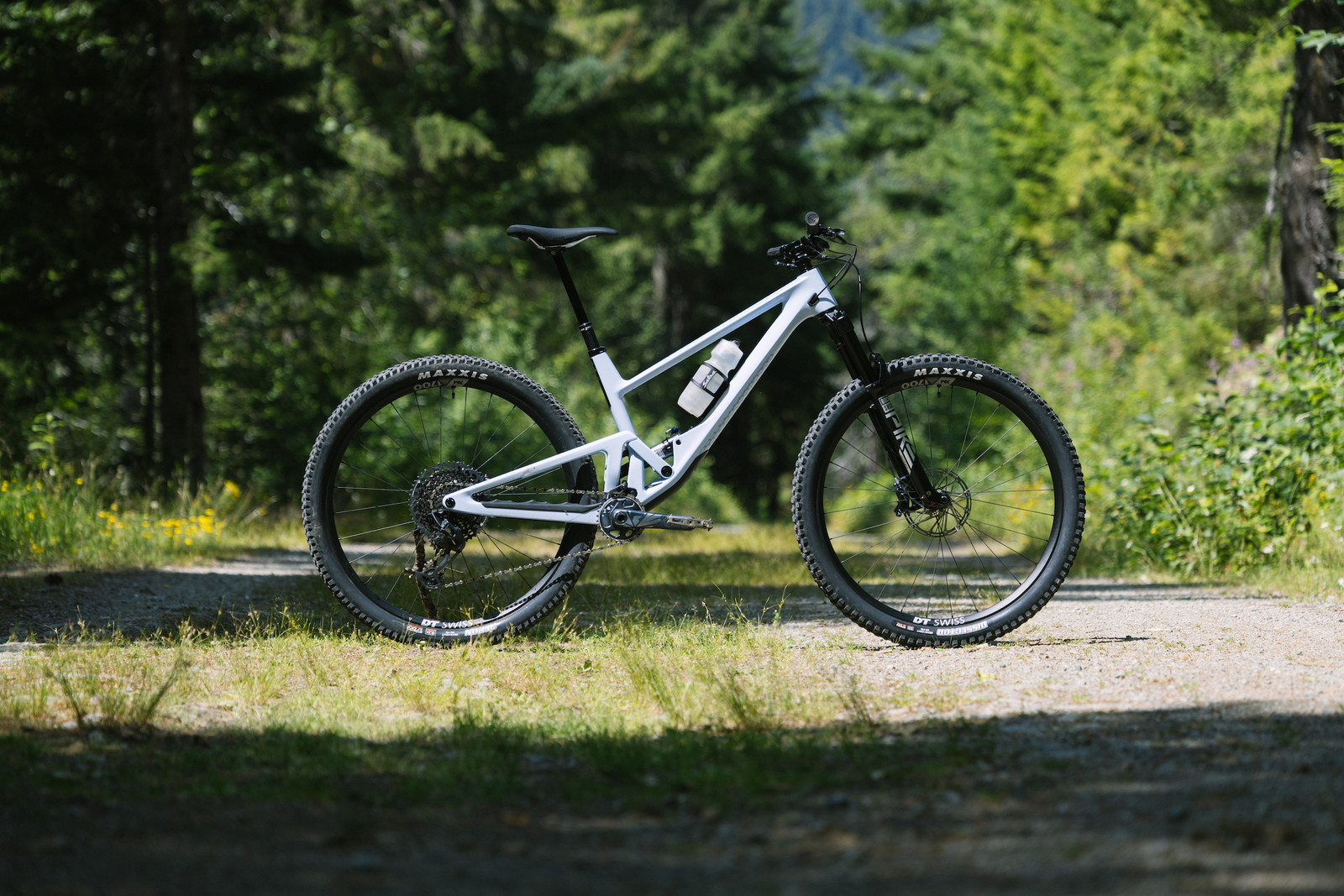Conceptualized in the depths of BMC’s R&D department, the sudden emergence of SCOR in 2021 quickly captured mass attention. With sleek and thoughtfully crafted bikes right from the get-go, it was clear the minds behind the designs had deliberate intentions with the brand. Driven by the philosophy that not everyone seeks podiums and race wins, SCOR wanted to create bikes that foster progression and unfiltered fun. You can still ride their bikes damn fast, and you’ll likely hit some unique lines in the process. Their inaugural 4060 model took this formula to heart, and the personality of SCOR bikes is perfectly illustrated in the creative style of SCOR athlete Josh Lewis(enjoy Loosedog's RAW from earlier this year).
With a trail and enduro model in their lineup, some of the crew at SCOR were craving a smaller bike to satisfy their adventurous needs. A bike that would fly uphill and be easy to toss around but remain capable and fun descending. The beauty of a brand operated by engineers and riders is desires quickly morph into reality. Introducing the 2030—a 120mm travel bike designed to ride less like a souped-up cross-country bike and more like a compact enduro bike.
2030 Highlights
- Full carbon frame (shares the same ASTM 4 strength standard as the 4060)
- 120mm of rear wheel travel // 140mm fork travel
- 130mm of travel possible with longer stroke shock
- Lower-link activated virtual pivot suspension design
- 29-inch wheels only
- 64.5-degree head tube angle (adjustable to 65.5-degrees)
- Two chain stay lengths depending on size: 329mm/332mm
- Stash Hatch internal storage
- Internally guided cable routing
- Accessory mount
- 12x148 Boost rear hub spacing
- 5 size
- 3 build kits + frame only option
- Verified weight (size M/L GX Build): 30.3 lbs (13.7 kgs)
- MSRP: $5,199 - $9,299 USD
Strengths |
Weaknesses |
|
|

Frame Details
The aggressive short travel bike category (or whatever you want to call it) is filled with bikes of various flavors. However, most are essential cross-country bikes with maybe a few geometry tweaks, a larger fork, and some burlier components to increase versatility.
The 2030 is not that kind of bike. SCOR sought to uphold its fun-first philosophy by creating a 120mm travel bike from the ground up that is more enjoyable to pedal than their 4060 ST but with a similar jump-off-of-anything, confidence-inspiring qualities. They achieved this 60% downhill, 40% uphill blend by curating a geometry package based off the 4060 ST, tweaking their suspension design to maximize the minimal travel on hand, and making component choices that error on the side of descending performance.

The full carbon frame meets the same ASTM 4 enduro strength test as the 4060 yet still strikes a low weight. Our medium/large test bike weighed 30.3 lbs, which we think is pretty ideal for long hauls in the saddle mixed with some mind-rattling trails. The pivots and hardware have been thoughtfully considered to simplify maintenance and feature double-sealed bearings without any pesky spacers. All cables run internally through guided ports in the frame, and a proprietary integrated chain guide cleverly attaches to the pivot of the lower link. Finally, custom frame protectors are available from Slicy's Mysublimstick app to customize your 2030.



Geometry
On paper, the 2030 is very similar to the 4060 ST (140mm travel configuration), which makes sense—both strive to be a ton of fun climbing and descending. However, their differences in travel and weight separate their performance and the intended use on the trail.

SCOR’s approach with geometry across all their bikes has always been longer front centers matched with short rear centers. We rode a size medium/large 2030 that flaunted a 477mm reach and a 429mm rear center (432mm on size L, XL). The idea behind this skewed ratio is the longer reach gives riders added confidence in steep, technical terrain while the compact rear center makes their bikes playful and active. Not a revolutionary concept nowadays, the rear centers are short for a dual 29-inch bike. The head tube angle is adjustable between 64.5 and 65.5 degrees but ships in the slacker position. We’d wager the head tube angle is the most significant factor contributing to the 2030’s ferocity descending compared to other short travel trail bikes that typically have 65+ degree head angles.
Stash Hatch
It wouldn’t be a new bike in 2023 without a way to store stuff inside the frame. While the 4060 does have internal storage accessed from below the downtube, the 2030 is the first model to feature the Stash Hatch. The incredibly sleek and low-profile door releases with a simple twist knob, and a waterproof pouch included inside helps organize belongings. A water bottle cage attaches to the door, and all sizes accommodate a 500ml bottle. Hydrate or die, people!

Aesthetically, the Stash Hatch is one of the best-executed door/latch systems we’ve seen. Smoothly integrated into the curves of the frame, the easy-to-twist release switch makes for hassle-free removal and installation. The downside is the cut-out in the frame isn’t massive, limiting what you can finagle into the 2030. We took out the included organizer and were able to stuff a tube and hand pump inside. But that was the extent of what was fitting.
Suspension Design
The 2030 uses SCOR’s distinct lower-link activated instant center suspension design that sees its virtual pivot point lower as the bike goes further into its travel. To squeeze as much capability as possible out of the 120mm of travel, the suspension is progressive to combat blowing through the travel. Anti-squat remains high until sag to ensure climbing efficiency and then fades to keep the 2030 stable and active as it gets deeper in its travel. Just like the 4060, the naming of the 2030 refers to the option to run 120 or 130mm of rear wheel travel. Riders just need to swap to a 52.5mm stroke shock. Lastly, a nifty bolt-on shock mudguard keeps your lower shock eyelet from getting pelted with grim.


Build Kits
SCOR is launching the 2030 with three build kits and a frame-only option. We tested the mid-tier GX build that retails for $7,299 USD, while the most expensive X01 build tops out at $9,299 USD. Just to get on a 2030, riders must cough up $5,199 USD for the NX build. All builds feature SRAM 4-piston brakes, SRAM Eagle 12-speed drivetrains, and Maxxis EXO casing tires.



Surprisingly, even the X01 build uses a mechanical drivetrain, and all builds come with only 180mm rotors front and rear. We also felt under gunned with the EXO casing tires when pushing the bike to its very capable limit. Big rotors and beefier tires would be our first and only upgrade to ride the 2030 how we imagine SCOR envisioned. Finally, the choice to go with a 140mm travel fork instead of a 130mm does bump up the bike's descending abilities. It might only be 10mm, but the added cushion and slightly longer axle to crown make a positive difference.
On The Trail
August is always a blur for mountain bike media personnel in the Northern Hemisphere. With prime weather popping off and long days, I’m usually bouncing between media camps, conducting Test Sessions, and making the annual pilgrimage to Crankworx Whistler. It’s easily my favorite time of the year. For the first time since I can remember, Crankworx fell on the final week of July, and that is where my journey with the 2030 began. Whistler is obviously a terrible place to ride bikes, and mixed weather during my first few shake-down rides forced me to enjoy a mix of tacky single track, slippery roots, and sun-baked forest floor broken up by slap-happy berms and jumps. Woe is me.


After religiously tuning into the Tour de France this summer, I had high hopes of racking up saddle time on the 2030. But with August turning into its usual circus after my Crankworx holiday, I’ve managed a very average amount of rides. Plenty to get familiar with the bike, but not enough to deem this a ‘long term’ review.
Sizing, Fit, and Setup
Creating a bike that’s supposed to climb better than a trail bike but rip harder than an XC bike leaves you with a few compromises depending on your preferences. As someone who sees climbing as a means to an end to reach my beloved descents, I tend to set my bikes up for the way back down. Lucky for me, the 2030 fit like a bike that’s more concerned about body positioning through rowdy sections than optimizing power output while in the saddle.

The size M/L was plenty big enough for my stature, with ample space to move within the bike. I found myself descending with my hips shifted back and heels heavy on my pedals, which made locking into sweeping corners simple and blissful. The stack height was lower than I prefer (617mm), causing my weight to shift forward. This made for a fast pedaling position but diminished my comfort on steeper trails. I resorted to adding 20mm of headset spacers to raise the front end and would jump to higher-rise handlebars if I had gnarlier trails at my disposal. The remainder of my setup was straightforward: I set sag to 30% in the rear and ran my saddle more neutral since the low front end was already pulling me forward.
Descending Performance
It sucks that SCOR plastered the launch of the 2030 with the word ‘fun’ because it so accurately describes the bike's personality. Yes, the bike industry tosses around the f-word rather carelessly, but it's hard to argue that short travel bikes like the 2030 pump life into dull or familiar trails. Thanks to the 2030’s stiff chassis and manageable weight, I had little trouble tossing the bike around as I pleased. Whether that was popping off natural rises in trails, doing my best Sam Hill impression cutting inside a corner, or switching lines mid-rock garden, the 2030 rarely resisted my creative lines. That same compact, responsive feel translated into excellent forward momentum when my inner race craved some raw speed and straight lines. I gravitated most towards trails with moderate pitches and minimal technical sections as they allowed me to ride creatively or tap into the efficiency of the 2030.

If ‘fun’ is overplayed, I’d use exciting as the second best way to describe the 2030. The combination of limited travel but slack enough geometry means that few trails are above the bike's ability, but increasingly technical trails require a methodical approach. If you are willing to hold on for the ride, the 2030 can manage some proper descents, but the margin for error is slim.

I had plenty of moments where a trail would casually weave down a hillside before suddenly dumping its elevation in a single tech section, leaving me in over my head. I was quickly reminded of the lighter wheels and tires beneath me and the limitations of 120/140mm of travel to soak up big compressions. But that surprise and excitement in those moments is one of my favorite aspects of bikes like the 2030—they keep you on your toes, engaged with the terrain, and eager to challenge your abilities on average sections of trail.
Climbing Performance
Climbing on the 2030 was everything I’d want from an aggressive 120mm travel bike—snappy, fast, efficient, and comfortable. It’s been a year since I’ve ridden a similar bike, and I forgot how enjoyable it is to hammer uphill when my average power output is rewarded with a higher average speed.

Even though I raised my handlebars and subscribe to #flatpedalswinmedals, I still found myself forward and able to smash on the pedals more than any trail bike I’ve tested. As someone who is competitive and only rides pedal-accessed trails, climbing on the 2030 felt like cheating compared to my daily 150mm travel bike, especially on smoother trails. Riding a bike that allowed me to experiment with various paces instead of being forced to settle into a mediocre pace was refreshing. I could put my head down and make a charge for a few minutes and then drop a few gears to catch my breath. For myself, that is not always the case with bikes of more travel. The only time I found the 2030 struggled uphill was in rocky terrain. The firmness of the rear suspension would begin to cause the bike to catch on large rocks or steps, and I had to be deliberate with my pedal strokes. In comparison, I rode the same rocky trails on a Santa Cruz Hightower with 145mm of travel and had no problem rolling over the same rock ledges.
For riders who primarily ride 150mm+ travel bikes, the ease at which you’ll motor up climbs on the 2030 will be very noticeable. For those who frequent genuine cross-country bikes, the 2030 won’t beat any of your PRs, but it’ll hold its own just fine. Plus, the added fun on the descent should compensate for any time lost on the climb. Even though I haven’t had the chance to log an all-day epic adventure on the 2030, I’m itching to get out for a day and cover some ground. I suspect its versatility and climbing comfort will make it an excellent weapon for getting lost in the hills.
Suspension Performance
SCOR did not want the abilities of the 2030 to be dictated by its travel amount since the goal was to provide riders with a ripping bike. I’d say they achieved that initiative, as the bike remained calm and planted through nastier sections than I anticipated. It still reminded me that I was only working with 120mm of travel through repetitive compressions or off medium-sized drops, but that’s to be expected with a short travel bike. Ultimately, I’m happy to give up some extra squish and carefree riding in exchange for an exciting descent and efficient pedal back to the top.

Weaknesses?
There isn’t much to poke holes in with the 2030 regarding frame design or manufacturing quality. Throughout my month-long test, the bike has remained dead silent, the sexy paint job has successfully endured a few rainy rides, and I’ve only had one linkage bolt come loose. The internal storage has also successfully held a tube and small multi-tool without rattling—job well done. Of course, time tells all, so take these impressions with a grain of salt, as I haven't had the opportunity to test the 2030 thoroughly. However, when we performed a long-term test of SCOR's 4060 LT, it faired very well after six months of abuse, and I would expect the same fate for the 2030.

What’s The Bottom Line?
The 2030 successfully delivers riders a platform with greater descending capabilities than most 120mm travel bikes while maintaining excellent efficiency and pace climbing. A super exciting and engaging bike, its snappy and responsive personality promotes creative lines. At home most on flowy, high-speed terrain where its fun can be maximized, it can still hold its own on advanced trails. Just be ready for a wild ride. But that is part of the allure of the 2030—its versatility unlocks unique ride qualities unknown to bikes with more or less travel. Perfect for riders wanting a smaller bike for all-day adventures or after-work power hours, the 2030 will breathe life into your riding style and favorite trails.
For more information, please visit scor-mtb.com
About The Tester
Jason Schroeder - Age: 28 // Years Riding MTB: 16 // Height: 6' (1.8m) // Weight: 175-pounds (79.3kg)
A once-upon-a-time World Cup downhill racer turned desk jockey, Jason has spent years within the bicycle industry from both sides of the tape. A fan of all-day adventures in the saddle or flowing around a bowl at the skatepark, he doesn't discriminate from any form of two-wheeled riding. A SoCal native who doesn't spend too much time in any single place, you can find Jason camped out in his van most weekends somewhere on the West Coast.








View replies to: FIRST RIDE - SCOR 2030 | Short-Travel Fun Machine
Comments